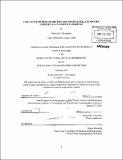Life cycle studies of the red tide dinoflagellate species complex Alexandrium tamarense
Author(s)
Brosnahan, Michael L. (Michael Lewis)
DownloadFull printable version (14.52Mb)
Other Contributors
Woods Hole Oceanographic Institution.
Advisor
Donald M. Anderson.
Terms of use
Metadata
Show full item recordAbstract
Blooms of toxic species within the algal dinoflagellate species complex Alexandrium tamarense may cause Paralytic Shellfish Poisoning, a significant and growing environmental threat worldwide. However, blooms of closely related nontoxic A. tamarense also occur, sometimes in close geographical proximity to toxic blooms. This thesis explores the interactions between toxic and nontoxic blooms by examining sexual crosses between each of five ribosomal clades within the A. tamarense complex (termed Groups I-V). Several lines of evidence argue that these clades represent separate species. Particular emphasis was given to interactions between toxic Group I and nontoxic Group III species because they are among the most closely related A. tamarense clades and because they share a natural range boundary in several parts of the world. Interspecies hybridization appeared widespread between different clades and between geographically dispersed isolates. However, subsequent germination studies of hypnozygotes produced from combinations of Group I and Group III clones failed to yield new vegetative cultures in multiple trials. The possibility that these hypnozygotes were actually inbred (i.e. the result of pairs of only Group I or only Group III gametes) was considered and rejected using a nested PCR assay that was developed to assess the parentage of individual cysts. The assay was also suitable for analyzing cysts collected from the field and was applied to individual cysts collected from Belfast Lough, an area where both Group I and Group III blooms were known to occur. Two Group I/Group III hybrids were detected in fourteen successful assays from the Belfast sample, showing that hybridization does occur in nature. These findings have several important implications. First, the failure of Group I/Group III hybrids to produce new vegetative cultures serves as a proof that the A. tamarense clades represent cryptic species because they are unable to produce genetic intermediates. Second, the presence of hybrid cysts in Belfast Lough indicates ongoing displacement of a nontoxic population by a toxic one (or vice versa) in that region. Third, the inviability of toxic/nontoxic hybrids suggests a remediation strategy whereby the recurrence of toxic A. tamarense blooms might be combated through the introduction of nontoxic cells. The results from these experiments also highlighted several shortfalls in our understanding of the mechanisms governing sexual compatibility between clones and also our ability to replicate these organisms' sexual cycle in the laboratory. Two initiatives were begun with the ultimate goal of better characterizing sexual processes in natural populations. The first initiative was the application of an imaging flow cytometer to detect sexual events in natural blooms. An existing instrument, the Imaging FlowCytobot, was adapted to positively identify A. tamarense Group I cells in mixed species assemblages and measure cell DNA content. A collection of four samples were analyzed, three from the development and decline of a local Group I bloom and one from a Group I red tide that occurred near Portsmouth, NH and led to a major deposition of new cysts in the southern Gulf of Maine. Several unanticipated patterns were revealed including the discovery of a persistent layer of cells with 2c DNA content near the surface and disproportionately high rates of infection by an Amoebophrya sp. parasite in large A. tamarense planozygotes. The second initiative was the application of high throughput Illumina sequencing to define the transcriptomes of toxic Group I, nontoxic Group III, and toxic Group IV clones. Additional steps were taken to isolate RNA and prepare a cDNA library from a natural sample of Group I hypnozygotes. The applications for these data are expected to be extensive and include the discovery of sexual biomarkers and further characterization of the differences between toxic and nontoxic A. tamarense species. Preliminary results from the sequencing of these libraries and their initial assembly are described.
Description
Thesis (Ph. D.)--Joint Program in Oceanography/Applied Ocean Science and Engineering (Massachusetts Institute of Technology, Dept. of Biology; and the Woods Hole Oceanographic Institution), 2011. Cataloged from PDF version of thesis. Includes bibliographical references.
Date issued
2011Department
Joint Program in Oceanography/Applied Ocean Science and Engineering; Woods Hole Oceanographic Institution; Massachusetts Institute of Technology. Department of BiologyPublisher
Massachusetts Institute of Technology
Keywords
Joint Program in Oceanography/Applied Ocean Science and Engineering., Biology., Woods Hole Oceanographic Institution.